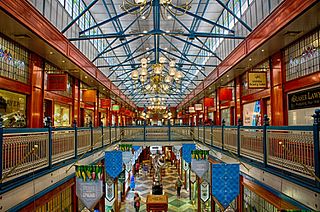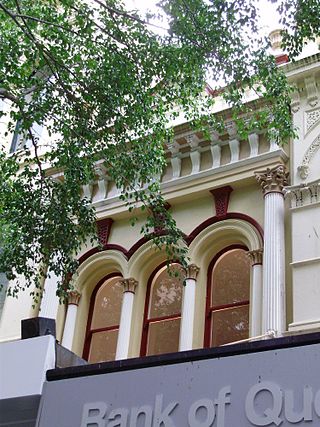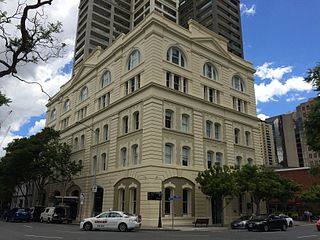
Brisbane Arcade is a heritage-listed shopping arcade at 160 Queen Street through to Adelaide Street in the Brisbane CBD, City of Brisbane, Queensland, Australia. Designed by Richard Gailey Jr. and constructed by J & E L Rees and Forsyth & Speering from 1923 to 1924, the arcade opened on April 16, 1924. It is the oldest and grandest shopping arcade in Brisbane. It was added to the Queensland Heritage Register on 21 October 1992.

169 Mary Street is a heritage-listed warehouse at 169 Mary Street, Brisbane CBD, City of Brisbane, Queensland, Australia. It was designed by Richard Gailey and built from 1887 to 1888 by T Game. It is also known as Coal Board Building. It was added to the Queensland Heritage Register on 21 October 1992.

The Allan and Stark Building is a heritage-listed row of contiguous but not identical retail buildings located at 110 Queen Street, Brisbane City, City of Brisbane, Queensland, Australia. The architect was Andrea Stombuco. It was also known as Myer Store. It was added to the Queensland Heritage Register on 21 October 1992.

Gardams Building is a heritage-listed retail building at 114 Queen Street, Brisbane City, City of Brisbane, Queensland, Australia. It was built in 1881. It is also known as Rutter and Sons. It was added to the Queensland Heritage Register on 21 October 1992.

Hardy Brothers Building is a heritage-listed shop at 116 Queen Street, Brisbane City, City of Brisbane, Queensland, Australia. It was designed by Richard Gailey and built in 1881. It is also known as Love's Auction Mart. It was added to the Queensland Heritage Register on 21 October 1992.

The Edwards and Chapman Building is a heritage-listed retail warehouse at 120 Queen Street, Brisbane City, City of Brisbane, Queensland, Australia. It was designed by Francis Drummond Greville Stanley and built from 1881 to 1882 by Henry Holmes. It was added to the Queensland Heritage Register on 21 October 1992.
Andrea Giovanni Stombuco (1820-1907) was an Italian-born Australian sculptor and architect. Many of the buildings he designed are listed on the heritage registers in Australia.

Tattersalls Club is a heritage-listed club house at 206 Edward Street, Brisbane City, Queensland, Australia. It was designed by Hall and Prentice and built from 1925 to 1949. It was added to the Queensland Heritage Register on 21 October 1992.

Tara House is a heritage-listed club house at 179 Elizabeth Street, Brisbane City, City of Brisbane, Queensland, Australia. It was designed by Richard Gailey and built from c. 1878 to 1928. It was also known as the Irish Club, which owned and operated the building from 1919 to 2015. It was added to the Queensland Heritage Register on 21 October 1992. It has now been converted to a cinema complex by the Sourris brothers retaining many of the original historical aspects of the building and its long history as the Brisbane Irish Club. The building is now known as The Elizabeth Picture Theatre.

Telecommunications House is a heritage-listed former clubhouse and now office building at 283 Elizabeth Street, Brisbane City, City of Brisbane, Queensland, Australia. It is also known as Corbett Chambers. It was designed by Claude William Chambers and built from 1906 to 1909 and was further extended c. 1914. It was added to the Queensland Heritage Register on 5 April 2004.

Charlotte House is a heritage-listed warehouse at 139–145 Charlotte Street, Brisbane CBD, City of Brisbane, Queensland, Australia. It was designed by John Joseph Lough and built from 1888 to 1889 by James Baker. It was added to the Queensland Heritage Register on 21 October 1992.

Old Mineral House is a heritage-listed warehouse at 2 Edward Street, Brisbane City, City of Brisbane, Queensland, Australia. It was designed by Richard Gailey and built from 1888 to 1890s by William Anthony. It is also known as Smellie & Co Warehouse and the Industrial High School. It was added to the Queensland Heritage Register on 21 October 1992.

Smellie's Building is a heritage-listed warehouse at 32 Edward Street, Brisbane City, City of Brisbane, Queensland, Australia. It was designed by Claude William Chambers and built from 1895 to 1896. It was added to the Queensland Heritage Register on 21 October 1992.

The R Martin & Co Building is a heritage-listed warehouse at 41 Edward Street, Brisbane City, City of Brisbane, Queensland, Australia. It was designed by Alexander Brown Wilson and built from 1885 to 1886 by Thomas Rees. It is also known as the South East Queensland Water Board Building, Brisbane & Area Water Board Building and Geedeejay House. It was added to the Queensland Heritage Register on 21 October 1992.

Spencers Building is a pair of heritage-listed warehouses at 45–47 and 49–51 Edward Street, Brisbane City, City of Brisbane, Queensland, Australia. It was designed by Francis Drummond Greville Stanley and built from 1889 to 1890 by Thomas Rees. It was added to the Queensland Heritage Register on 27 August 1993.

Youngs Building is a heritage-listed warehouse at 93–103 Edward Street, Brisbane City, City of Brisbane, Queensland, Australia. It was built in 1910 and repaired in 1912. It is also known as Optical Products. It was added to the Queensland Heritage Register on 22 February 1995.

Hunters Buildings is a heritage-listed group of commercial buildings at 179–191 George Street, Brisbane City, City of Brisbane, Queensland, Australia. The individual buildings are Treasury Chambers, St Francis House, and Symons Building. They were designed by Richard Gailey and built in 1886 by George Gazzard. They were added to the Queensland Heritage Register on 21 October 1992.

Watson Brothers Building is a heritage-listed warehouse at 129 Margaret Street, Brisbane City, City of Brisbane, Queensland, Australia. It was designed by Richard Gailey and built from 1887 to 1918. It was added to the Queensland Heritage Register on 23 April 1999.

AMP Building is a heritage-listed office building at 183 East Street, Rockhampton, Rockhampton Region, Queensland, Australia. It was designed by Francis Drummond Greville Stanley and built in 1888. It is also known as Brahman House. It was added to the Queensland Heritage Register on 21 October 1992.

The Buildings of St Joseph's College, Nudgee is a heritage-listed group of school buildings at St Joseph's College, Nudgee at 2199 Sandgate Road, Boondall, City of Brisbane, Queensland, Australia. They were built from 1891 to c. 1960. The school is also known as Nudgee College and St Joseph's Nudgee College. The buildings added to the Queensland Heritage Register on 6 November 2006.






















